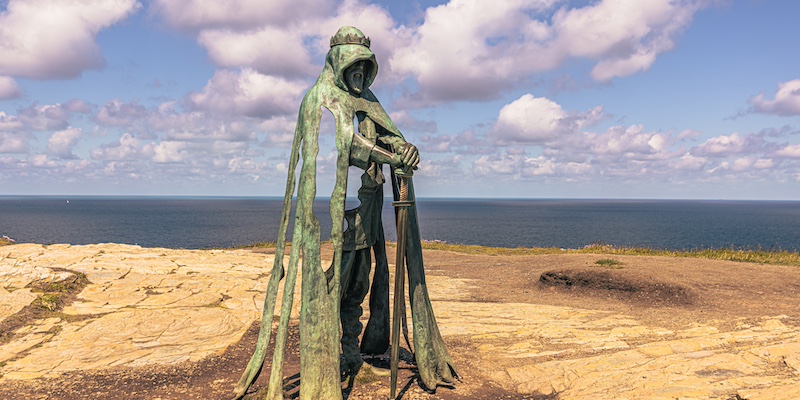Unlike English native-speakers, I didn’t really encounter gothic novels in the first twenty-or-so years of my life. I grew up in the French-speaking part Switzerland, and my modern and medieval literature studies focused on French authors and their preoccupations. Therefore hearing the concept of ‘gothic’ as a formative genre for the English psyche didn’t really mean much to me… or so I thought. I moved to the UK in 2008 and started voraciously absorbing books and TV programmes and visiting stately homes during weekends, until I realised I had somehow internalised gothic tropes; dark castles, ominous clouds, supernatural and madness seemed suddenly part of my artistic subconscious.
When it came to writing my second novel, I found myself setting the action in D’Arvor, a made-up mysterious and awe-inspiring medieval castle, and delving deep into a world of artefacts, deception and manipulation. I didn’t set the story in the UK, however, but in Brittany, the North-Western tip of France of famously jagged and awe-inspiring landscapes. Once I had the setting, I started weaving in a gothic undertone, almost subconsciously, and Arthurian legends quickly emerged as a strong theme in the novel. I soon realised that those stories of knights and forests, castles and madness I had studied at University carried proto-gothic themes all along, and the overlap became more and more obvious as I worked.
Arthurian legends are rife in Brittany, home of the Brocéliande forest, where tourists can visit places such as Merlin’s tomb and the Val-Sans-Retour, a breath-taking valley where Morgane trapped unfaithful lovers (you can still see their (alleged) bodies of stone). During a research trip in summer 2023 I visited all those places and considered how much the Arthurian legends stemmed from the atmosphere of the landscapes, and how much these stories were, in return, feeding the gothic atmosphere of my novel. Having intended, originally, to set the story by the sea, it became obvious that Brocéliande was its natural place, and its rich motifs would help build an atmosphere of superstition and madness.
But what are some these motifs and how do they relate to what is now commonly accepted as gothic tropes?
1. Castles
Set in medieval society, Arthurian stories quite naturally feature many castles. Tintagel in Cornwall, and its stunning ruins looking over a jagged coastline and Merlin’s cave, claims to be the place Arthur was conceived; the castle of Comper, in Brocéliande, allegedly hides Vivian’s crystal palace at the bottom of its lake. The fact that those places are now atmospheric ruins, adds to the feeling of awe that takes grip when exploring a place haunted by history and legend. Some castles in Arthurian matter are also imbued with supernatural and danger, such as she Castle of Worst Adventure, in which Yvain fights two demons to free three-hundred maidens, or the Chateau des Reines, where Gawain meets his dead mother and manages to survive a night being attacked by arrows in an enchanted bed. Castles in gothic novels are also rife with supernatural and can act as liminal places between the living and the dead; Dracula’s castle is one example, as is Manderley, famously haunted by the former presence of Rebecca. The weight of legend and history, the secret passages and shadowy corners make castles the perfect backdrop to play with some of the themes; D’Arvor, the castle at the centre of The Estate, has its own lake, and its own haunting secrets too.
2. Madness
Medieval writers did not shy away from describing madness: Lancelot suffers a bout of insanity when Guinevere finds out that Elaine tricked him into sleeping with her; Yvain becomes a madman rambling in the woods when failing to get back to his wife after the agreed period of a year. Madness reveals a character to be, sometimes momentarily, acting out of societal norms. These ‘mad’ Arthurian knights have all failed in meeting their lady’s expectations as courtly knights. Lewis’sThe Monk takes this a step further and madness turns into lust and obsession, with shocking consequences. Another aspect of madness in the gothic stems from a blurred boundary between the natural and the supernatural: what of what I’m seeing is real, and what is only in my head? The protagonist of my novel The Estate feels like she is tipping slowly into madness, as she starts questioning her own judgement of who she can trust, and what to believe. Following her own integrity against the flow will threaten to have her presented as ‘unstable’, just like some gothic heroines were.
3. Romance
Earlier French novels were called ‘romances’, and as they depicted the adventures of knights and their courtly love, the term started being associated with love stories. Arthurian tales are rife with passion and intrigue, often linked with deception and manipulation. Merlin magically alters Uther’s appearance to enable him to sleep with Ygraine and father Arthur, for example, and Lancelot cheats on Guinevere because of a similar deception. In this world, remaining pure of heart and deed is indeed challenging. Such are the dilemmas of Ann Radcliffe’s heroines, engaged in their own battle between good and evil, and fighting to be with their loved ones. Another motif emerges: that of the rich, mysterious, brooding and possibly hero, whom Jane Eyre or the anonymous heroine of Rebecca will find themselves falling for. The heroine of The Estate, Camille Leray, will find herself similarly drawn into lust and obsession for the owner of D’Arvor.
It seems obvious that Arthurian legends and gothic novels share an interest for similar themes: the porous division between natural and supernatural, liminal places, madness and romance. All of these themes reveal some overlap between the preoccupations of the medieval and Victorian psyches. I wonder what the revival of gothic fiction in our era says about our own sense of unease and thirst for fantasy and danger. I guess you’ll have to read The Estate if you’re interested in my take on the subject.
***


















